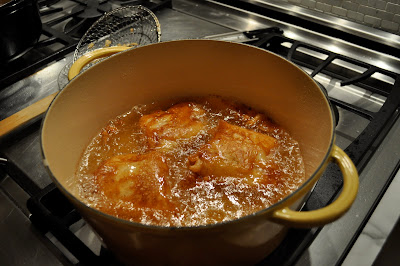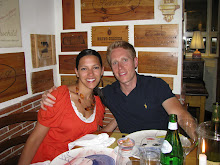Before I knew about Homefood, I read an article in the New York Times several years ago about how people in Palermo have opened eating establishments in their houses (not entirely legal, but not offensive enough to warrant government intervention), their dining rooms spilling out onto the sidewalks of the city, allowing hungry people to walk in and enjoy a sampling of local cuisine, basically whatever the owner decides to put on the menu for that day.
Having my buddy over recently for a sort of short notice dinner made me think how nice it would be, maybe in simpler times, to have an informal establishment of my own that would welcome people in to dine on whatever offerings I thought of on a given day. Not a full fledged restaurant with all its liabilities and constraints, just a little lunch spot like Louis' Lunch or something, albeit with more spontaneity, at least in the beginning.
 When Asher asked for some tagliatelle if I was up for it on a Sunday evening, the gears started cranking and this recipe is what I came up with. Since he keeps kosher, the easiest option was to stay vegetarian.
When Asher asked for some tagliatelle if I was up for it on a Sunday evening, the gears started cranking and this recipe is what I came up with. Since he keeps kosher, the easiest option was to stay vegetarian. It's Spring now, but the weather wasn't exactly harbinger-ing Summer's warm breezes prior to this week, so I wanted to highlight some of the sweet green sprouting things of the moment but also stay hearty and satisfying for a one dish meal.
Ragu Finto describes the application of mushrooms in this case, ground up prior to cooking to resemble in appearance and texture a meat sauce. Never too liquidy when I'm at the helm, the sauce coats the strands of fresh pasta kind of like a thick pesto, but it's cooked and reduced some, so I think it qualifies as a sauce or ragu.
To make the pestata or pasty base for the ragu I processed the onion, celery and garlic just as I would later do for the shrooms into tiny bits to make it homogeneous (leave a couple mushrooms just diced for the fun of it). With some red wine and Thai fish sauce (just a tad) substituting salted anchovies, the end product had depth of flavor and earthiness that I thought would do well to support a final garnish of truffle oil, the inclusion of which Asher requested. Anchovies or fish sauce you ask? Why, yes...not to impart fishiness to it, just to add a curious element of flavor and salinity that you will appreciate but not easily discern as coming from the sea.
To bring Spring into the fold, I cut the tips off asparagus and threw them in to just cook through in the ragu for a few minutes before plating. I took the remaining portion of the asparagus and very thinly sliced them, mixing in at the last second without cooking because I wanted that raw sweetness and crunch against the woodsy sauce. Some more fresh pop from parsley, along with Parmigiano Reggiano and truffle oil, and I think we hit most or all of the notes.
We currently have seating for 6 and reservations 4 hours or more in advance are greatly appreciated...
Serves 4
Ingredients:
2 1/2 - 3 lbs. mushrooms (your choice, but try to mix in some more flavorful ones and even some dried)
1 bunch of asparagus
1 medium onion
2 cloves garlic
2 ribs celery
1 cup red wine (nothing too fruity)
3 tablespoons extra virgin olive oil
Pinch or two of hot pepper flakes
2 anchovy fillets, rinsed well, or 2 teaspoons Asian fish sauce
Optional: 1/2 cup light cream
Optional: 1 cup meat, chicken or vegetable stock
Salt & pepper to tasteHandful of fresh parsley, finely chopped
Parmigiano Reggiano to garnish
Optional: fresh truffle or truffle oil for garnish
1 recipe fresh egg pasta cut to fettuccine or tagliatelle, recipe follows
Pulse all the mushrooms, save a handful, until they are finely minced and set aside. Dice the handful into 1/2" pieces. Then process the onion, celery and garlic until it becomes almost a paste. Heat the olive oil on medium and when it shimmers add the onion, celery and garlic and cook, letting the considerable liquid sweat out, 10-12 minutes. When the onions begin to brown, add the mushrooms and turn the heat to high. Cook, stirring occasionally, until the mushrooms have released most of their liquid, 15-20 minutes.
Add the red wine a cup at a time and let it mostly evaporate. Add the cream, then add the anchovies or fish sauce, the pepper flakes and some water or stock and bring to a boil, then reduce to a simmer and cook, stirring occasionally and adding ladles of liquid to keep it from getting too dry, for about 40 minutes.
In the meantime, cut the tough ends off the asparagus and remove the tips, setting them aside. Take the stalks and slice very thin, using a mandolin if you prefer. When the sauce has finished cooking, season to taste with salt and pepper, turn off the heat and add the tips of the asparagus.
To finish the dish, cook the pasta 2-4 minutes in salted water, then drain and toss with some of the ragu in a bowl or frying pan, adding pasta water if need be to make it adhere well to the noodles. Serve with Parmigiano Reggiano, parsley and some thinly sliced truffle or truffle oil for us wannabes.
Egg pasta for 4:
4 jumbo eggs
400 grams or about 3 1/2 cups 00 or AP flour
1 tablespoon extra virgin olive oil
Mound the flour on a work surface and make a well about 8 inches in diameter. Add the eggs to the well and scramble with a fork, then add the oil. Using the fork incorporate the flour from the inner walls into the egg. Be careful not to break the wall and lose the eggs before you have a fairly well composed mass of dough. Put the fork aside when most of the wet and dry are mixed and form a rough ball.
Knead the dough for 8 to 12 minutes, adding flour conservatively if it's very wet and resting periodically, until the dough stretches and is supple and smooth. Wrap it in plastic and let rest 20 to 30 minutes.
To make the tagliatelle or fettuccine, using a pasta roller or rolling pin roll out segments of dough until it's thin enough for light to pass through. Cut it into a rectangle that's 10 inches long on one side (that'll be the length of the noodles). Lightly flour the dough if it's sticky and roll it over itself from bottom to top. Then take a knife and cut every 1/4 inch or thereabouts and unravel the noodles. Alternatively, follow instructions for a pasta machine or attachment. Form the noodles into little nests of about a serving apiece. Lightly flour with semolina or cornmeal. Freeze it if you don't place on using it immediately. To cook it later do not thaw--go from freezer to boiling water.
Egg pasta for 4:
4 jumbo eggs
400 grams or about 3 1/2 cups 00 or AP flour
1 tablespoon extra virgin olive oil
Mound the flour on a work surface and make a well about 8 inches in diameter. Add the eggs to the well and scramble with a fork, then add the oil. Using the fork incorporate the flour from the inner walls into the egg. Be careful not to break the wall and lose the eggs before you have a fairly well composed mass of dough. Put the fork aside when most of the wet and dry are mixed and form a rough ball.
Knead the dough for 8 to 12 minutes, adding flour conservatively if it's very wet and resting periodically, until the dough stretches and is supple and smooth. Wrap it in plastic and let rest 20 to 30 minutes.
To make the tagliatelle or fettuccine, using a pasta roller or rolling pin roll out segments of dough until it's thin enough for light to pass through. Cut it into a rectangle that's 10 inches long on one side (that'll be the length of the noodles). Lightly flour the dough if it's sticky and roll it over itself from bottom to top. Then take a knife and cut every 1/4 inch or thereabouts and unravel the noodles. Alternatively, follow instructions for a pasta machine or attachment. Form the noodles into little nests of about a serving apiece. Lightly flour with semolina or cornmeal. Freeze it if you don't place on using it immediately. To cook it later do not thaw--go from freezer to boiling water.




















